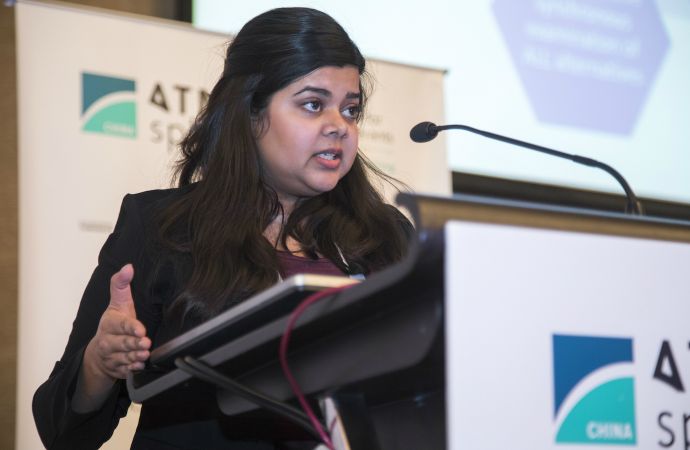Refrigerant, equipment and building standards must be revised for natural refrigerants to fulfil their potential, the EIA told ATMOsphere China.

Avipsa Mahapatra, EIA addresses ATMOsphere China in Beijing.
Photo credit: Ben Beech.
Refrigerant standards, equipment standards and building codes and standards must be revised now if natural refrigerants are to fulfil their maximum potential as market-ready replacements for HCFCs and HFCs being phased down under the Montreal Protocol, heard ATMOsphere China participants this week.
“The Montreal Protocol and its Kigali Amendment impose time constraints – the key timeframe for standards revision is 2018-2022,” said Avipsa Mahapatra, climate change lead at the Environmental Investigation Agency, an NGO.
“To make sure the right technology is adopted in this timeframe, a sense of urgency is key,” said Mahapatra. “This applies to both the HCFC phasedown in developing countries and the HFC phasedown in developed countries.”
On refrigerant standards, Mahapatra cited ASHRAE 34 and ISO 817 classifying flammability and toxicity as key standards to work on. On the equipment side, IEC 60335-2-40 on air-conditioning appliances for household and similar purposes is similarly important.
“Natural refrigerants are already there as market-ready replacements,” the EIA campaigner said. “But they’re not reaching their potential because safety standards are deliberately and artificially restrictive.”
Mahapatra called for broader representation on standards-setting bodies around the world, from the full spectrum of HVAC&R industry players and from representatives of developing as well as developed countries.
“The international committees that set these standards are made by the f-gas industry, with no government oversight,” she lamented. “We need smarter standards that comprehensively and synchronously examine all the different refrigerant options.”
Mahapatra cited limited scope of work, lack of resources, limited participation by A5 countries, and prioritisation of certain refrigerants over others among the obstacles limiting the effectiveness of standards bodies in ensuring a level playing field. “We need to give these committees sufficient resources, and provide basic transparency on how these groups work,” she said.
“The natural refrigerants industry must be represented on these groups,” she argued.
Natural refrigerants are already there as market-ready replacements. But they’re not reaching their potential because safety standards are deliberately and artificially restrictive.”
– Avipsa Mahapatra, EIA
Chinese companies must engage
Mahapatra called on Chinese companies to “actively engage” in IEC SC61D/WG16 on room air conditioners. “Progress is being made on standards, including in the United States. Engagement by Chinese industry – which produces most of the world’s air conditioners – has helped,” she said.
“But we cannot sit back. Continued engagement is needed to champion the safety and efficiency of hydrocarbons,” Mahapatra argued.
On the light commercial refrigeration side, she expressed hope that a CDV proposal to increase the hydrocarbon charge limit to 500g in standalone equipment would be finalised in IEC SC61C WG4 this month.
“Natural refrigerants can be safely, efficiently and cost-effectively adopted around the world,” Mahapatra said. “It would be a shame if they were to fail to fulfil their potential, simply because the right people weren’t sitting around the right table when the standards were being drawn up.”
“Let’s work together on this – the future of our planet depends on it,” she said.
Related stories



